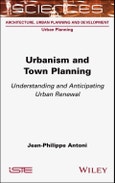Sustainable urban planning and urban renewal are major challenges of the 21st century. In this context, Urbanism and Town Planning proposes a geohistorical approach to urban construction.
The city and its neighborhoods are studied through their materials and general layout, which sometimes reveal a logic of economic profitability, prestige and social equity, and sometimes a more innovative approach from an environmental perspective. Across these elements, unbuilt spaces (distinctive streets and squares) and built spaces (commercial and residential areas, both individual and collective) form a three-dimensional grid of "voids" and "solids", characteristic of urban landscapes and lifestyles.
Supported by numerous original examples, this book is a comprehensive summary of the most tangible elements of urban planning and development; elements that must be put into context in order to think concretely about the development of the cities of the future.
Table of Contents
Introduction ix
Chapter 1 Elements of History 1
1.1 The city limits 3
1.1.1 The river and the hill 3
1.1.2 From enclosures to boulevards 8
1.2 The classical city 15
1.2.1 The Greek city 15
1.2.2 The Roman city 24
1.2.3 The medieval city 31
1.3 The modern city 38
1.3.1 The industrial city 38
1.3.2 The reactionary city 43
1.3.3 Urban sprawl and the "death of the city" 50
1.4 Conclusion 56
Chapter 2 Materials of the Urban Fabric 61
2.1 Traditional materials 63
2.1.1 Wood 63
2.1.2 Cob 67
2.1.3 Raw earth 70
2.1.4 Brick 73
2.1.5 Stone 77
2.2 Technical innovations 81
2.2.1 Iron and steel 81
2.2.2 Concrete 85
2.3 Urban fabric: elements of definition 90
2.4 Conclusion 96
Chapter 3 City Maps 99
3.1 Quadrangular plans 101
3.1.1 Linear and fishbone plans 102
3.1.2 Parallel street plans and checkerboard plans 105
3.1.3 Advantages and disadvantages 110
3.2 The radioconcentric plans 114
3.2.1 The star plan 115
3.2.2 The circular plan 119
3.2.3 The spider web plan 122
3.2.4 Advantages and disadvantages 128
3.3 Stratified plans 131
3.3.1 Open planning and slab planning 132
3.3.2 Underground urban planning 138
3.3.3 New urban planning and TOD 146
3.4 Conclusion 150
Chapter 4 Unbuilt Spaces: Squares and Streets 153
4.1 Streets 154
4.1.1 Elements of definition 155
4.1.2 The avenue and the boulevard 158
4.1.3 Promenades and piers 163
4.1.4 Closed streets: dead ends, rackets and combs teeth 166
4.1.5 Stairs 170
4.2 Urban squares 172
4.2.1 Elements of definition 173
4.2.2 Marketplaces 178
4.2.3 Demonstration squares 182
4.2.4 Traffic squares 186
4.2.5 Amenity spaces 192
4.3 Facilities 197
4.3.1 Layout 197
4.3.2 Aediculae 201
4.3.3 Street furniture 206
4.4 Conclusion 211
Chapter 5 Built-up Areas: Buildings and Neighborhoods 213
5.1 Elements of definition 214
5.1.1 Building and housing 215
5.1.2 Built form and alignment 222
5.1.3 Neighborhoods and mixed functions 227
5.2 Collective and multi-functional buildings 234
5.2.1 From the insula to the Haussmann building 235
5.2.2 Large-scale projects and skyscrapers 243
5.2.3 Participatory urban planning 250
5.3 Individual and single-function buildings 254
5.3.1 Evolution of commercial and industrial functions 255
5.3.2 From the domus to gated communities 263
5.3.3 The illusions of diversity 269
5.4 Conclusion 276
Conclusion 279
References 283
Index 287








